Canon SX50 vs Panasonic FZ200
The Canon PowerShot SX50 HS and the Panasonic Lumix DMC-FZ200 are two digital cameras that were announced, respectively, in September 2012 and July 2012. Both the SX50 and the FZ200 are fixed lens compact cameras that are equipped with a 1/2.3-inch sensor. Both cameras offer a resolution of 12 megapixels.
Below is an overview of the main specs of the two cameras as a starting point for the comparison.

Check SX50 offers at
ebay.com

Check FZ200 offers at
ebay.com
Going beyond this snapshot of core features and characteristics, what are the differences between the Canon PowerShot SX50 HS and the Panasonic Lumix DMC-FZ200? Which one should you buy? Read on to find out how these two cameras compare with respect to their body size, their imaging sensors, their shooting features, their input-output connections, and their reception by expert reviewers.
Body comparison
An illustration of the physical size and weight of the Canon SX50 and the Panasonic FZ200 is provided in the side-by-side display below. The two cameras are presented according to their relative size. Three consecutive views from the front, the top, and the rear side are shown. All width, height and depth dimensions are rounded to the nearest millimeter.
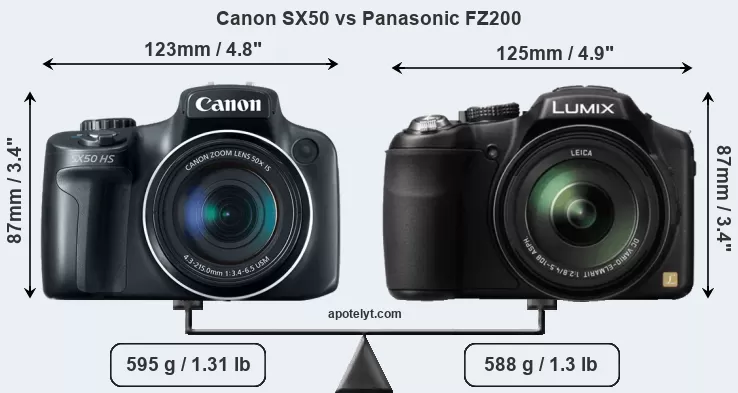
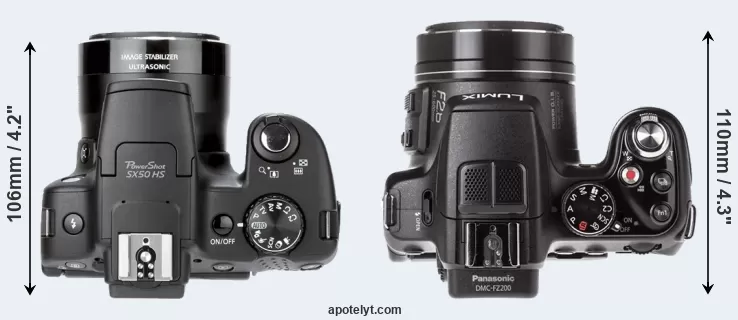
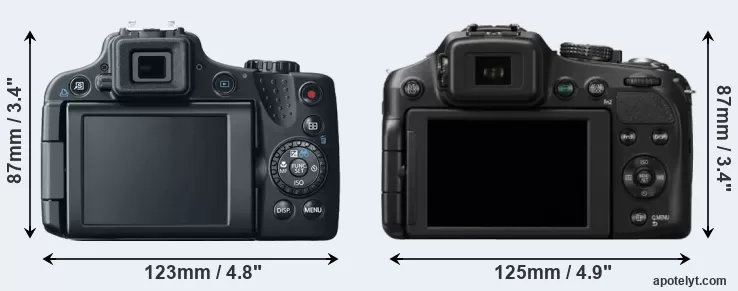
If the front view area (width x height) of the cameras is taken as an aggregate measure of their size, the Panasonic FZ200 is somewhat larger (2 percent) than the Canon SX50. However, the FZ200 is slightly lighter (1 percent) than the SX50. In this context, it is worth noting that neither the SX50 nor the FZ200 are weather-sealed.
Concerning battery life, the SX50 gets 315 shots out of its Canon NB-10L battery, while the FZ200 can take 540 images on a single charge of its Panasonic DMW-BLC12 power pack.
The following table provides a synthesis of the main physical specifications of the two cameras and other similar ones. In case you want to display and compare another camera duo, you can use the CAM-parator app to select your camera combination among a large number of options.

| Camera Model |
Camera Width |
Camera Height |
Camera Depth |
Camera Weight |
Battery Life |
Weather Sealing |
Camera Launch |
Launch Price (USD) |
Street Price |
||
|---|---|---|---|---|---|---|---|---|---|---|---|
| 1. | Canon SX50 | 123 mm | 87 mm | 106 mm | 595 g | 315 | n | Sep 2012 | 429 | ebay.com | |
| 2. | Panasonic FZ200 | 125 mm | 87 mm | 110 mm | 588 g | 540 | n | Jul 2012 | 599 | ebay.com | |
| 3. | Canon G1 X | 117 mm | 81 mm | 65 mm | 534 g | 250 | n | Jan 2012 | 799 | ebay.com | |
| 4. | Canon G15 | 107 mm | 76 mm | 40 mm | 352 g | 350 | n | Sep 2012 | 499 | ebay.com | |
| 5. | Canon G16 | 109 mm | 76 mm | 40 mm | 356 g | 360 | n | Aug 2013 | 549 | ebay.com | |
| 6. | Canon S120 | 100 mm | 59 mm | 29 mm | 217 g | 230 | n | Aug 2013 | 449 | ebay.com | |
| 7. | Canon SX10 | 123 mm | 88 mm | 87 mm | 600 g | .. | n | Sep 2008 | 399 | ebay.com | |
| 8. | Canon SX20 | 123 mm | 88 mm | 87 mm | 600 g | .. | n | Aug 2009 | 399 | ebay.com | |
| 9. | Canon SX30 | 123 mm | 92 mm | 108 mm | 601 g | 370 | n | Sep 2010 | 429 | ebay.com | |
| 10. | Canon SX40 | 123 mm | 92 mm | 108 mm | 600 g | 380 | n | Sep 2011 | 429 | ebay.com | |
| 11. | Canon SX60 | 128 mm | 93 mm | 114 mm | 650 g | 340 | n | Sep 2014 | 549 | ebay.com | |
| 12. | Panasonic FZ100 | 124 mm | 82 mm | 92 mm | 540 g | 410 | n | Jul 2010 | 499 | ebay.com | |
| 13. | Panasonic FZ150 | 124 mm | 82 mm | 92 mm | 528 g | 410 | n | Aug 2011 | 499 | ebay.com | |
| 14. | Panasonic FZ300 | 132 mm | 92 mm | 117 mm | 691 g | 380 | Y | Jul 2015 | 599 | amazon.com | |
| Note: Measurements and pricing do not include easily detachable parts, such as add-on or interchangeable lenses or optional viewfinders. | |||||||||||
Any camera decision will obviously take relative prices into account. The retail prices at the time of the camera’s release place the model in the market relative to other models in the producer’s line-up and the competition. The SX50 was launched at a markedly lower price (by 28 percent) than the FZ200, which puts it into a different market segment. Usually, retail prices stay at first close to the launch price, but after several months, discounts become available. Later in the product cycle and, in particular, when the replacement model is about to appear, further discounting and stock clearance sales often push the camera price considerably down. Then, after the new model is out, very good deals can frequently be found on the pre-owned market.
Sensor comparison
The size of the sensor inside a digital camera is one of the key determinants of image quality. A large sensor will tend to have larger individual pixels that provide better low-light sensitivity, wider dynamic range, and richer color-depth than smaller pixel-units in a sensor of the same technological generation. Moreover, a large sensor camera will give the photographer more control over depth-of-field in the image and, thus, the ability to better isolate a subject from the background. On the downside, larger sensors are more costly to manufacture and tend to lead to bigger and heavier cameras and lenses.
Both cameras under consideration feature a 1/2.3-inch sensor and have a format factor (sometimes also referred to as "crop factor") of 5.6. Within the spectrum of camera sensors, this places the review cameras among the smaller-sensor digicams that favor affordability and compact design. Both cameras feature a native aspect ratio (sensor width to sensor height) of 4:3.
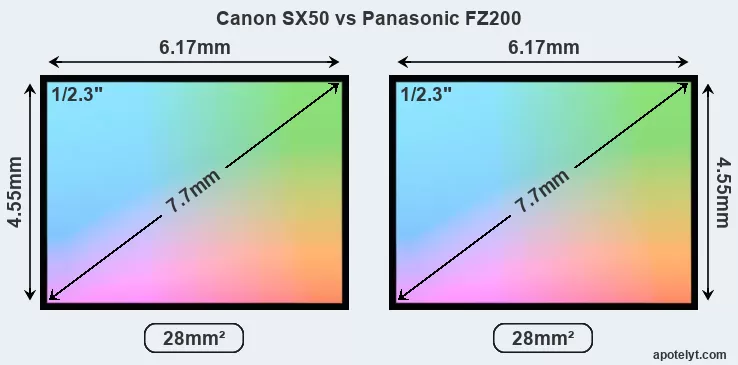
The two cameras under review do not only share the same sensor size, but also offer an identical resolution of 12 megapixels. This similarity in sensor specs implies that both the SX50 and the FZ200 have the same pixel density, as well as the same pixel size. Moreover, the two cameras were released in close succession, so that their sensors are from the same technological generation. Coming back to sensor resolution, it should be mentioned that the FZ200 has no anti-alias filter installed, so that it can capture all the detail its sensor resolves.
The Canon PowerShot SX50 HS has a native sensitivity range from ISO 80 to ISO 6400. The corresponding ISO settings for the Panasonic Lumix DMC-FZ200 are ISO 100 to ISO 3200, with the possibility to increase the ISO range to 100-6400.
Technology-wise, both cameras are equipped with BSI-CMOS (Backside Illuminated Complementary Metal–Oxide–Semiconductor) sensors. Both cameras use a Bayer filter for capturing RGB colors on a square grid of photosensors. This arrangement is found in most digital cameras.
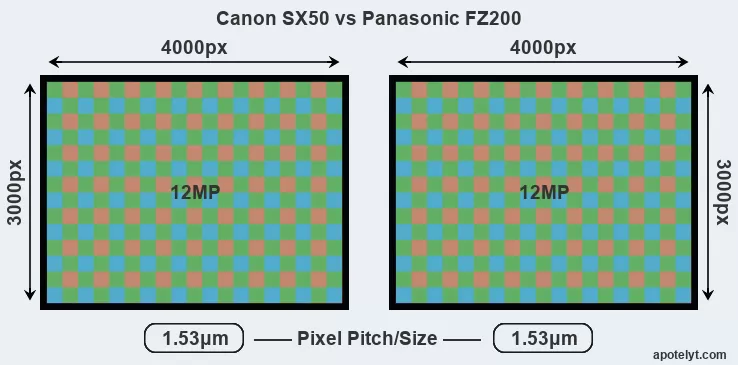
For many cameras, data on sensor performance has been reported by DXO Mark. This service assesses and scores the color depth ("DXO Portrait"), dynamic range ("DXO Landscape"), and low-light sensitivity ("DXO Sports") of camera sensors, and also publishes an overall camera score. Of the two cameras under review, the SX50 has a notably higher overall DXO score than the FZ200 (overall score 10 points higher), which gives it an advantage in terms of imaging quality. This advantage is based on 1.2 bits higher color depth, 0.4 EV in additional dynamic range, and 0.7 stops in additional low light sensitivity. The following table provides an overview of the physical sensor characteristics, as well as the sensor quality measurements for a selection of comparators.

| Camera Model |
Sensor Class |
Resolution (MP) |
Horiz. Pixels |
Vert. Pixels |
Video Format |
DXO Portrait |
DXO Landscape |
DXO Sports |
DXO Overall |
||
|---|---|---|---|---|---|---|---|---|---|---|---|
| 1. | Canon SX50 | 1/2.3 | 12.0 | 4000 | 3000 | 1080/24p | 20.3 | 11.2 | 179 | 47 | |
| 2. | Panasonic FZ200 | 1/2.3 | 12.0 | 4000 | 3000 | 1080/60p | 19.1 | 10.8 | 114 | 37 | |
| 3. | Canon G1 X | 1.5-inch | 14.2 | 4352 | 3264 | 1080/24p | 21.7 | 10.8 | 644 | 60 | |
| 4. | Canon G15 | 1/1.7 | 12.0 | 4000 | 3000 | 1080/24p | 19.9 | 11.5 | 165 | 46 | |
| 5. | Canon G16 | 1/1.7 | 12.0 | 4000 | 3000 | 1080/60p | 21.0 | 11.7 | 230 | 54 | |
| 6. | Canon S120 | 1/1.7 | 12.0 | 4000 | 3000 | 1080/60p | 21.3 | 11.9 | 246 | 56 | |
| 7. | Canon SX10 | 1/2.3 | 10.0 | 3648 | 2736 | 480/30p | 19.0 | 10.3 | 144 | 35 | |
| 8. | Canon SX20 | 1/2.3 | 12.0 | 4000 | 3000 | 720/30p | 19.2 | 10.5 | 225 | 37 | |
| 9. | Canon SX30 | 1/2.3 | 14.0 | 4320 | 3240 | 720/30p | 19.4 | 10.7 | 320 | 39 | |
| 10. | Canon SX40 | 1/2.3 | 12.0 | 4000 | 3000 | 1080/24p | 19.6 | 10.9 | 409 | 41 | |
| 11. | Canon SX60 | 1/2.3 | 14.2 | 4608 | 3072 | 1080/60p | 19.2 | 10.8 | 127 | 39 | |
| 12. | Panasonic FZ100 | 1/2.3 | 14.0 | 4320 | 3240 | 1080/60i | 19.4 | 10.7 | 306 | 39 | |
| 13. | Panasonic FZ150 | 1/2.3 | 12.0 | 4000 | 3000 | 1080/60p | 19.4 | 10.9 | 132 | 40 | |
| 14. | Panasonic FZ300 | 1/2.3 | 12.0 | 4000 | 3000 | 4K/30p | 19.3 | 11.0 | 97 | 38 | |
| Note: DXO values in italics represent estimates based on sensor size and age. | |||||||||||
Many modern cameras cannot only take still pictures, but also record videos. The two cameras under consideration both have sensors whose read-out speed is fast enough to capture moving pictures, but the FZ200 provides a faster frame rate than the SX50. It can shoot movie footage at 1080/60p, while the Canon is limited to 1080/24p.
Feature comparison
Beyond body and sensor, cameras can and do differ across a range of features. The two cameras under review are similar with respect to both having an electronic viewfinder. However, the one in the FZ200 offers a substantially higher resolution than the one in the SX50 (1312k vs 202k dots). The following table reports on some other key feature differences and similarities of the Canon SX50, the Panasonic FZ200, and comparable cameras.

| Camera Model |
Viewfinder (Type or 000 dots) |
Control Panel (yes/no) |
LCD Specifications (inch/000 dots) |
LCD Attach- ment |
Touch Screen (yes/no) |
Max Shutter Speed * |
Max Shutter Flaps * |
Built-in Flash (yes/no) |
Built-in Image Stab |
||
|---|---|---|---|---|---|---|---|---|---|---|---|
| 1. | Canon SX50 | 202 | n | 3.0 / 461 | swivel | n | 1/2000s | 2.2/s | Y | Y | |
| 2. | Panasonic FZ200 | 1312 | n | 3.0 / 460 | swivel | n | 1/4000s | 12.0/s | Y | Y | |
| 3. | Canon G1 X | optical | n | 3.0 / 922 | swivel | n | 1/4000s | 1.9/s | Y | Y | |
| 4. | Canon G15 | optical | n | 3.0 / 922 | fixed | n | 1/4000s | 2.1/s | Y | Y | |
| 5. | Canon G16 | optical | n | 3.0 / 922 | fixed | n | 1/4000s | 2.2/s | Y | Y | |
| 6. | Canon S120 | none | n | 3.0 / 922 | fixed | Y | 1/2000s | 12.1/s | Y | Y | |
| 7. | Canon SX10 | 202 | n | 2.5 / 230 | swivel | n | 1/3200s | 0.7/s | Y | Y | |
| 8. | Canon SX20 | 202 | n | 2.5 / 230 | swivel | n | 1/3200s | 0.7/s | Y | Y | |
| 9. | Canon SX30 | 202 | n | 2.7 / 230 | swivel | n | 1/3200s | 0.6/s | Y | Y | |
| 10. | Canon SX40 | 202 | n | 2.7 / 230 | swivel | n | 1/3200s | 10.3/s | Y | Y | |
| 11. | Canon SX60 | 922 | n | 3.0 / 922 | swivel | n | 1/2000s | 6.4/s | Y | Y | |
| 12. | Panasonic FZ100 | 202 | n | 3.0 / 460 | swivel | n | 1/2000s | 11.0/s | Y | Y | |
| 13. | Panasonic FZ150 | 202 | n | 3.0 / 460 | swivel | n | 1/2000s | 12.0/s | Y | Y | |
| 14. | Panasonic FZ300 | 1440 | n | 3.0 / 1040 | swivel | Y | 1/4000s | 12.0/s | Y | Y | |
| Note: *) Information refers to the mechanical shutter, unless the camera only has an electronic one. | |||||||||||
Both the SX50 and the FZ200 have zoom lenses built in. The SX50 has a 24-1200mm f/3.4-6.5 optic and the FZ200 offers a 25-600mm f/2.8-2.8 (focal lengths in full frame equivalent terms). Hence, the Canon provides a wider angle of view at the short end, as well as more tele-photo reach at the long end than the Panasonic. The FZ200 offers the faster maximum aperture.
Concerning the storage of imaging data, both the SX50 and the FZ200 write their files to SDXC cards. The FZ200 supports UHS-I cards (Ultra High Speed data transfer of up to 104 MB/s), while the SX50 cannot take advantage of Ultra High Speed SD cards.
Connectivity comparison
For some imaging applications, the extent to which a camera can communicate with its environment can be an important aspect in the camera decision process. The table below provides an overview of the connectivity of the Canon PowerShot SX50 HS and Panasonic Lumix DMC-FZ200 and, in particular, the interfaces the cameras (and selected comparators) provide for accessory control and data transfer.

| Camera Model |
Hotshoe Port |
Internal Mic / Speaker |
Microphone Port |
Headphone Port |
HDMI Port |
USB Port |
WiFi Support |
NFC Support |
Bluetooth Support |
||
|---|---|---|---|---|---|---|---|---|---|---|---|
| 1. | Canon SX50 | Y | stereo / mono | - | - | mini | 2.0 | - | - | - | |
| 2. | Panasonic FZ200 | Y | stereo / mono | Y | - | mini | 2.0 | - | - | - | |
| 3. | Canon G1 X | Y | stereo / mono | - | - | mini | 2.0 | - | - | - | |
| 4. | Canon G15 | Y | stereo / mono | - | - | mini | 2.0 | - | - | - | |
| 5. | Canon G16 | Y | stereo / mono | - | - | mini | 2.0 | Y | - | - | |
| 6. | Canon S120 | - | stereo / mono | - | - | mini | 2.0 | Y | - | - | |
| 7. | Canon SX10 | Y | stereo / mono | - | - | - | 2.0 | - | - | - | |
| 8. | Canon SX20 | Y | stereo / mono | - | - | YES | 2.0 | - | - | - | |
| 9. | Canon SX30 | Y | stereo / mono | - | - | YES | 2.0 | - | - | - | |
| 10. | Canon SX40 | Y | stereo / mono | - | - | YES | 2.0 | - | - | - | |
| 11. | Canon SX60 | Y | stereo / mono | Y | - | mini | 2.0 | Y | Y | - | |
| 12. | Panasonic FZ100 | Y | stereo / mono | - | - | mini | 2.0 | - | - | - | |
| 13. | Panasonic FZ150 | Y | stereo / - | - | - | mini | 2.0 | - | - | - | |
| 14. | Panasonic FZ300 | Y | stereo / mono | Y | - | mini | 2.0 | Y | - | - |
It is notable that the FZ200 has a microphone port, which can help to improve the quality of audio recordings by attaching an external microphone. The SX50 does not feature such a mic input.
Both the SX50 and the FZ200 have been discontinued, but can regularly be found used on ebay. The FZ200 was replaced by the Panasonic FZ300, while the SX50 was followed by the Canon SX60. Further information on the features and operation of the SX50 and FZ200 can be found, respectively, in the Canon SX50 Manual (free pdf) or the online Panasonic FZ200 Manual.
Review summary
So what conclusions can be drawn? Which of the two cameras – the Canon SX50 or the Panasonic FZ200 – has the upper hand? Is one clearly better than the other? A synthesis of the relative strong points of each of the models is listed below.

Arguments in favor of the Canon PowerShot SX50 HS:
- Better moiré control: Has an anti-alias filter to avoid artificial patterns to appear in images.
- Better image quality: Scores markedly higher (10 points) in the DXO overall assessment.
- Richer colors: Generates images with noticeably better colors (1.2 bits more color depth).
- Better low-light sensitivity: Requires less light for good images (0.7 stops ISO advantage).
- Wider view: Has a wider-angle lens that facilitates landscape or interior shots.
- More tele-reach: Has a longer tele-lens for perspective compression and subject magnification.
- More affordable: Was introduced into a lower priced category (28 percent cheaper at launch).

Reasons to prefer the Panasonic Lumix DMC-FZ200:
- Maximized detail: Lacks an anti-alias filter to exploit the sensor's full resolution potential.
- Better video: Provides higher movie framerates (1080/60p versus 1080/24p).
- Better sound: Can connect to an external microphone for higher quality sound recording.
- More detailed viewfinder: Has higher resolution electronic viewfinder (1312k vs 202k dots).
- Faster shutter: Has higher mechanical shutter speed (1/4000s vs 1/2000s) to freeze action.
- Faster burst: Shoots at higher frequency (12 vs 2.2 flaps/sec) to capture the decisive moment.
- Better light gathering: Has a lens with a wider maximum aperture (f/2.8 vs f/3.4).
- Longer lasting: Gets more shots (540 versus 315) out of a single battery charge.
- Faster buffer clearing: Has an SD card interface that supports the UHS-I standard.
If the number of relative strengths (bullet points above) is taken as a guide, the FZ200 emerges as the winner of the match-up (9 : 7 points). However, the relevance of individual strengths will vary across photographers, so that you might want to apply your own weighing scheme to the summary points when reflecting and deciding on a new camera. A professional wedding photographer will view the differences between cameras in a way that diverges from the perspective of a travel photog, and a person interested in cityscapes has distinct needs from a macro shooter. Hence, the decision which camera is best and worth buying is often a very personal one.
How about other alternatives? Do the specifications of the Canon SX50 and the Panasonic FZ200 place the cameras among the top in their class? Find out in the latest Best Superzoom Camera listing whether the two cameras rank among the cream of the crop.
In any case, while the comparison of technical specifications can provide a useful overview of the capabilities of different cameras, it says little about, for example, the shooting experience and imaging performance of the SX50 and the FZ200 in practical situations. User reviews, such as those found at amazon, can sometimes inform about these issues, but such feedback is often incomplete, inconsistent, and biased.
Expert reviews
This is why expert reviews are important. The table below provides a synthesis of the camera assessments of some of the best known photo-gear review sites (amateurphotographer [AP], cameralabs [CL], digitalcameraworld [DCW], dpreview [DPR], ephotozine [EPZ], photographyblog [PB]). As can be seen, the professional reviewers agree in many cases on the quality of different cameras, but sometimes their assessments diverge, reinforcing the earlier point that a camera decision is often a very personal choice.

| Camera Model |
AP score |
CL score |
DCW score |
DPR score |
EPZ score |
PB score |
Camera Launch |
Launch Price (USD) |
Street Price |
||
|---|---|---|---|---|---|---|---|---|---|---|---|
| 1. | Canon SX50 | 3/5 | + + | .. | 72/100 | 4.5/5 | 4.5/5 | Sep 2012 | 429 | ebay.com | |
| 2. | Panasonic FZ200 | 3/5 | + + | .. | 80/100 | 4.5/5 | 4.5/5 | Jul 2012 | 599 | ebay.com | |
| 3. | Canon G1 X | 5/5 | + | .. | 76/100 | 4/5 | 4.5/5 | Jan 2012 | 799 | ebay.com | |
| 4. | Canon G15 | 4/5 | + | .. | 76/100 | 4.5/5 | 4.5/5 | Sep 2012 | 499 | ebay.com | |
| 5. | Canon G16 | 4/5 | + | .. | .. | 4.5/5 | 4.5/5 | Aug 2013 | 549 | ebay.com | |
| 6. | Canon S120 | .. | + + | .. | .. | 4.5/5 | 4.5/5 | Aug 2013 | 449 | ebay.com | |
| 7. | Canon SX10 | .. | + + | .. | .. | .. | 4/5 | Sep 2008 | 399 | ebay.com | |
| 8. | Canon SX20 | .. | + + | .. | 73/100 | .. | 4/5 | Aug 2009 | 399 | ebay.com | |
| 9. | Canon SX30 | 3/5 | + + | .. | .. | 3.5/5 | 4/5 | Sep 2010 | 429 | ebay.com | |
| 10. | Canon SX40 | .. | + | .. | .. | 4.5/5 | 4/5 | Sep 2011 | 429 | ebay.com | |
| 11. | Canon SX60 | 3/5 | + + | .. | 75/100 | 4/5 | 4.5/5 | Sep 2014 | 549 | ebay.com | |
| 12. | Panasonic FZ100 | .. | + | .. | .. | 4.5/5 | 4.5/5 | Jul 2010 | 499 | ebay.com | |
| 13. | Panasonic FZ150 | 3/5 | + + | .. | 76/100 | 4/5 | 4.5/5 | Aug 2011 | 499 | ebay.com | |
| 14. | Panasonic FZ300 | .. | + + | .. | .. | 4.5/5 | 4.5/5 | Jul 2015 | 599 | amazon.com | |
| Note: (+ +) highly recommended; (+) recommended; (o) reviewed; (..) not available. | |||||||||||
The review scores listed above should be treated with care, though. The assessments were made in relation to similar cameras of the same technological generation. Thus, a score needs to be put into the context of the launch date and the launch price of the camera, and rating-comparisons among cameras that span long time periods or concern very differently equipped models make little sense. Also, please note that some of the review sites have changed their methodology and reporting over time.

Check SX50 offers at
ebay.com

Check FZ200 offers at
ebay.com
Other camera comparisons
Did this review help to inform your camera decision process? If you would like to see a different side-by-side camera review, just use the search menu below. There is also a set of direct links to comparison reviews that other users of the CAM-parator app explored.
- Canon 50D vs Canon SX50
- Canon M6 Mark II vs Panasonic FZ200
- Canon RP vs Panasonic FZ200
- Canon SX50 vs Canon SX60
- Canon SX50 vs Fujifilm X-A1
- Canon SX50 vs Fujifilm X-E1
- Canon SX50 vs Panasonic TZ90
- Canon SX50 vs Sony RX1
- Nikon D810 vs Panasonic FZ200
- Olympus E-300 vs Panasonic FZ200
- Panasonic FZ200 vs Panasonic FZ2500
- Panasonic FZ200 vs Panasonic LX100 II
Specifications: Canon SX50 vs Panasonic FZ200
Below is a side-by-side comparison of the specs of the two cameras to facilitate a quick review of their differences and common features.
| Camera Model | Canon SX50 | Panasonic FZ200 |
|---|---|---|
| Camera Type | Fixed lens compact camera | Fixed lens compact camera |
| Camera Lens | 24-1200mm f/3.4-6.5 | 25-600mm f/2.8 |
| Launch Date | September 2012 | July 2012 |
| Launch Price | USD 429 | USD 599 |
| Sensor Specs | Canon SX50 | Panasonic FZ200 |
| Sensor Technology | BSI-CMOS | BSI-CMOS |
| Sensor Format | 1/2.3" Sensor | 1/2.3" Sensor |
| Sensor Size | 6.17 x 4.55 mm | 6.17 x 4.55 mm |
| Sensor Area | 28.0735 mm2 | 28.0735 mm2 |
| Sensor Diagonal | 7.7 mm | 7.7 mm |
| Crop Factor | 5.6x | 5.6x |
| Sensor Resolution | 12 Megapixels | 12 Megapixels |
| Image Resolution | 4000 x 3000 pixels | 4000 x 3000 pixels |
| Pixel Pitch | 1.53 μm | 1.53 μm |
| Pixel Density | 42.74 MP/cm2 | 42.74 MP/cm2 |
| Moiré control | Anti-Alias filter | no AA filter |
| Movie Capability | 1080/24p Video | 1080/60p Video |
| ISO Setting | 80 - 6,400 ISO | 100 - 3,200 ISO |
| ISO Boost | no Enhancement | 100 - 6,400 ISO |
| Image Processor | DIGIC 5 | Venus VII FHD |
| DXO Sensor Quality (score) | 47 | 37 |
| DXO Color Depth (bits) | 20.3 | 19.1 |
| DXO Dynamic Range (EV) | 11.2 | 10.8 |
| DXO Low Light (ISO) | 179 | 114 |
| Screen Specs | Canon SX50 | Panasonic FZ200 |
| Viewfinder Type | Electronic viewfinder | Electronic viewfinder |
| Viewfinder Field of View | 100% | 100% |
| Viewfinder Magnification | 0.46x | |
| Viewfinder Resolution | 202k dots | 1312k dots |
| LCD Framing | Live View | Live View |
| Rear LCD Size | 3.0inch | 3.0inch |
| LCD Resolution | 461k dots | 460k dots |
| LCD Attachment | Swivel screen | Swivel screen |
| Shooting Specs | Canon SX50 | Panasonic FZ200 |
| Focus System | Contrast-detect AF | Contrast-detect AF |
| Continuous Shooting | 2.2 shutter flaps/s | 12 shutter flaps/s |
| Fill Flash | Built-in Flash | Built-in Flash |
| Storage Medium | SDXC cards | SDXC cards |
| Single or Dual Card Slots | Single card slot | Single card slot |
| UHS card support | no | UHS-I |
| Connectivity Specs | Canon SX50 | Panasonic FZ200 |
| External Flash | Hotshoe | Hotshoe |
| USB Connector | USB 2.0 | USB 2.0 |
| HDMI Port | mini HDMI | mini HDMI |
| Microphone Port | no MIC socket | External MIC port |
| Wifi Support | no Wifi | no Wifi |
| Body Specs | Canon SX50 | Panasonic FZ200 |
| Battery Type | Canon NB-10L | Panasonic DMW-BLC12 |
| Battery Life (CIPA) | 315 shots per charge | 540 shots per charge |
| Body Dimensions |
123 x 87 x 106 mm (4.8 x 3.4 x 4.2 in) |
125 x 87 x 110 mm (4.9 x 3.4 x 4.3 in) |
| Camera Weight | 595 g (21.0 oz) | 588 g (20.7 oz) |

Check SX50 offers at
ebay.com

Check FZ200 offers at
ebay.com
Did you notice an error on this page? If so, please get in touch, so that we can correct the information.

